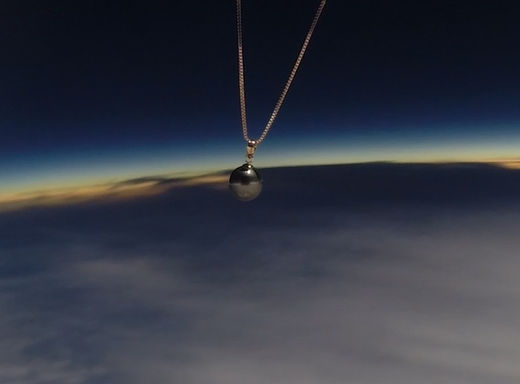BWeaves
Well-known member
Astronomer hubby Greg just showed me this article.
Scroll down today (Monday, 6-May-2024) to the Solar Eclipse Tahitian pearl.
Since the article may roll off the page as more articles are posted, I'll copy it here.
TAHITIAN BLACK SOLAR ECLIPSE PEARL: It came from Tahiti, and now it has touched the shadow of the Moon. On April 8, 2024, the students of Earth to Sky Calculus launched this black pearl into a total eclipse of the sun over Texas. Riding on a cosmic ray research balloon, the pearl was 86,564 feet high when lunar darkness swallowed it for 3 minutes 45 seconds:
You can have it for $299.95. Measuring 9 mm in diameter, this genuine Tahitian pearl has an 18K rose gold clasp and is suspended from a matching 925 Sterling Silver chain. It comes with a greeting card showing the pearl in flight and telling the story of its journey to the edge of space during the 2024 total eclipse.
------------
Here's the link if you want to buy it, with more photos.

 www.earthtosky.store
www.earthtosky.store
At least the pearl got to experience the eclipse over Texas, because the extra photos show Texas completely clouded over. Nobody on the ground saw the eclipse there.
Scroll down today (Monday, 6-May-2024) to the Solar Eclipse Tahitian pearl.
Since the article may roll off the page as more articles are posted, I'll copy it here.
TAHITIAN BLACK SOLAR ECLIPSE PEARL: It came from Tahiti, and now it has touched the shadow of the Moon. On April 8, 2024, the students of Earth to Sky Calculus launched this black pearl into a total eclipse of the sun over Texas. Riding on a cosmic ray research balloon, the pearl was 86,564 feet high when lunar darkness swallowed it for 3 minutes 45 seconds:
You can have it for $299.95. Measuring 9 mm in diameter, this genuine Tahitian pearl has an 18K rose gold clasp and is suspended from a matching 925 Sterling Silver chain. It comes with a greeting card showing the pearl in flight and telling the story of its journey to the edge of space during the 2024 total eclipse.
------------
Here's the link if you want to buy it, with more photos.

Tahitian Black Solar Eclipse Pearl | Earthtosky.store
It came from Tahiti--and now it has touched the shadow of the Moon. On April 8, 2024, the students of Earth to Sky Calculus launched this black pearl into a total eclipse of the sun over Texas. Riding on a cosmic ray research ballon, the pearl was 86,564 feet high when the Moon's shadow...
 www.earthtosky.store
www.earthtosky.store
At least the pearl got to experience the eclipse over Texas, because the extra photos show Texas completely clouded over. Nobody on the ground saw the eclipse there.

